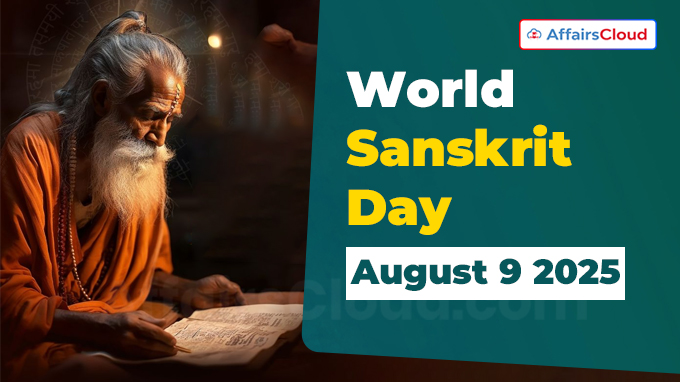
World Sanskrit Day, also known as International Sanskrit Day/Sanskrit Diwas/Vishva Samskrita Dinam, is annually observed across the globe on Shravana Purnima, the full moon day of the Hindu month of Shravana (Sawan) to promote Sanskrit, one of India’s oldest languages.
- World Sanskrit Day 2025 was observed on August 9 2025.
- World Sanskrit Day 2024 was observed on 19th August 2024 and World Sanskrit Day 2026 will be observed on 28 August 2026.
- Sanskrit Week 2025 is being observed from 6 to 12 August 2025.
Exam Hints:
- Event: World Sanskrit Day 2025 (Vishva Samskrita Dinam)
- When? 9th August 2025 (Shravana Purnima)
- Purpose: To promote Sanskrit, one of the world’s oldest languages
- Sanskrit Week 2025: 6th to 12th August 2025.
- 1st observance: Initiated in 1969 by GoI.
- Status in India: Declared as a classical language in 2005
Significance:
Commemoration: The day marks the birth anniversary of Panini, the renowned Sanskrit scholar and grammarian.
- He authored the Ashtadhyayi in the 5th century BCE, which laid the foundation of Classical Sanskrit grammar.
Cultural Association: The day coincides with Raksha Bandhan, a festival symbolising the bond between brothers and sisters.
Background:
Government Initiative: In 1969, the Ministry of Education (MoE), Government of India (GoI), directed that Sanskrit Diwas be celebrated at both central and state levels across India.
1st Observance: World Sanskrit Day was first celebrated in 1969 by GoI.
2025 Event:
State Initiatives: The Gujarat State Sanskrit Board organised a three-day programme (6th–8th August 2025) under the ‘Yojana Panchakam’ framework, including Sanskrit Gaurav Yatra, Sanskrit Sambhashan Divas, and Sanskrit Sahitya Divas.
International Participation: Events were also held in Nepal at Valmiki Vidyapeeth, Nepal Sanskrit University, and by global organisations promoting Sanskrit.
About Sanskrit Language:
Ancient Origin: Sanskrit is among the world’s oldest languages and is regarded as the “Mother of All Languages” as well as the “Language of the Gods.”
Etymology: The word ‘Sanskrit’ comes from ‘Sam’ (samyak – entirely) and ‘krit’ (done), meaning “perfectly done.”
Literary Periods – Divided into two major phases:
- Vedic Sanskrit – The earliest form, part of the Indo-Aryan branch of the Indo-European language family.
- Classical Sanskrit – A later development from Old Indo-Aryan dialects.
Sanskrit in India:
Classical Status: In 2005, the GoI declared Sanskrit as a Classical Language of India and included it in the Eighth Schedule of the Constitution, which lists 22 officially recognized languages.
Cultural Role: Sanskrit is the medium of ancient Indian scriptures like the Vedas, Upanishads, Ramayana, and Mahabharata, influencing philosophy, literature, science, and arts.
Official Language Status in States:
Uttarakhand: In 2010, Uttarakhand became the first Indian state to make Sanskrit an official language alongside Hindi.
- The Uttarakhand Government initiated the development of ‘Sanskrit Grams’ to encourage daily use of Sanskrit among residents.
Himachal Pradesh: In 2019, Himachal Pradesh (HP) became the second Indian state to grant Sanskrit the status of an official language.




